Note: This is a spoiler free review of EXIT: The Game.
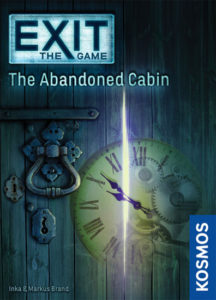 Escape Rooms are an incredibly fast growing trend. About 5 years ago, I had never heard of one. Now, there are half a dozen within my immediate area alone. If you haven’t tried one before, it involves you and a group of friends being locked in a room together. You typically have 60 minutes to solve a linear path of puzzles to eventually make your way through the exit door. It’s an activity that’s both exiting really unique.
Escape Rooms are an incredibly fast growing trend. About 5 years ago, I had never heard of one. Now, there are half a dozen within my immediate area alone. If you haven’t tried one before, it involves you and a group of friends being locked in a room together. You typically have 60 minutes to solve a linear path of puzzles to eventually make your way through the exit door. It’s an activity that’s both exiting really unique.
Today, we are going to be taking a look at EXIT: The Game, a new series of games from publisher Kosmos. With EXIT, Kosmos is trying to recreate the feel of an escape room on our tabletops using a series of cards. So let’s lock the doors and see how EXIT holds up.
EXIT: The Game is a puzzle and deduction game for 1-6 players that takes about 60-90 minutes to play. EXIT plays best with 2-3 players.
Game Overview:
In EXIT, players are trying to solve a series of puzzles and open the “locked door” of the room they are in, all as quickly as possible. While each game of EXIT has its own theme (currently Abandoned Cabin, Secret Lab, and Pharaoh’s Tomb), the goal remains the same. Start the timer and use the clues at your disposal to solve a series of puzzles to ultimately escape.
Game Components:
While each game of EXIT is slightly different, the main component in EXIT is going to be the cards. They come in three different flavors: Puzzle, Answer, and Clue. It should be fairly obvious what each one does. The other component of note is the decoder wheel. This is use during the game to direct players to specific answer cards. I should also note that EXIT is considered a “legacy” style game, and you will most likely be destroying some components as you play.
How to Play:
The basic game play of EXIT is fairly simple. You start off with a rulebook, a decoder ring, and a few piles of cards (as noted above). Usually you will have access to one or more puzzle cards at the start of the game. Each puzzle will require some deduction, observation, or clever thinking to solve.
Once you think you have an answer for a puzzle card, you input the solution into the decoder wheel. This will direct you to a specific answer card. If the card shows a big red ”X”, you’ve guessed wrong and will have to rethink your solution. If the answer card leads you to a correct guess card, you will be given addition puzzles to solve.
Should you get stuck, every puzzle has a series of clue cards. These start out generic and eventually will reveal the exact solution. As you work your way through the puzzles, ultimately you’ll open the final “lock” in the game and make your way out of the room. Your final score will be based on how long you took and how many clues you used.
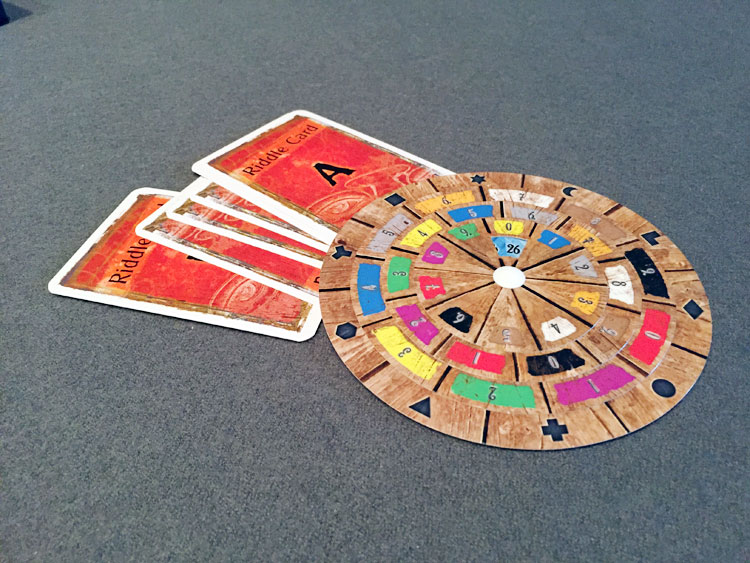
Game Experience:
In this mega review, Tony, Brian, and Andrew will each be talking about their own experiences with their copy of EXIT: The Game.
Tony (The Abandoned Cabin):
I have mixed feelings on EXIT. I’m a huge fan of escape rooms, having played more than a few already. I played the Abandoned Cabin version of EXIT, which I felt was the most intriguing (and escape room like) theme of the 3 available options.
When it came to puzzles, there was actually a nice variety in the box. Some of them I got right away as they just clicked, while others had me searching for answers. However some were completely out of left field and I don’t think we would have ever gotten to the correct solution without the help cards. Normally I wouldn’t care, but when you are in a timed scenario, that’s kind of frustrating.
Now there were some SUPER clever puzzles as well. Without getting into spoilers, I will say that I was impressed with KOSMOS’s creativity and their ability to think outside of the box. There was one or two puzzles in particular that almost made my giddy when I realized what the answer was.
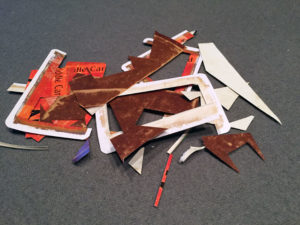
But frankly, the big miss with me with EXIT is the card system. While it works, it feels really clunky. Having to constantly dig cards out of the answer deck, and then put them back in, really took us out of the flow of the game. In an age where board games are becoming more and more integrated with digital apps, this felt like a big miss for me. The EXIT card mechanic system feels like it should have come out about 3 years ago. Today, it just feels dated.
But other than those two issues, which I admit are not exactly minor, we did enjoy EXIT. We had to cut up and destroy quite a few components, meaning this is absolutely a one and done game. But at about a $15 price point, I’m wouldn’t complain as long as we were having a fun time. I supposed you could try and solve the game without destroying anything, but it will make your life a lot harder.
Brian (The Secret Lab):
I like Escape Rooms and I REALLY like board games; unfortunately, I did not enjoy my EXIT: The Game experience.
The main issue I have with EXIT is the components used during the game. It only includes one journal and the Help, Riddle, and Answer cards are all poker sized. When you are playing with a larger group of players (4+), it makes it difficult for everyone to be involved when there is only one journal and the cards are not very large. In my group’s opinion, this game would have benefited greatly from including multiple journals to be shared at the table, as well as printing the clues on tarot sized cards, understanding and accepting that this would have increased the cost of the game.
This issue is compounded by most of the puzzles having to be solved in a linear fashion. If multiple puzzles could have been solved simultaneously, this would have alleviated the player engagement issue we encountered.
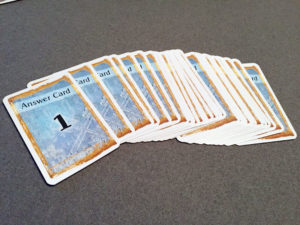
Finally, we were disappointed that the complexity of the puzzles did not mesh with the recommended minimum player age of 12+. We played the game with two of our children, a twelve year old and a thirteen year old. After about a half hour, one had his head on the table and the other was writing song lyrics on her scratch paper. Several of the puzzles were way too complicated for them to logically work their way to an answer. This was one of the biggest misses for me as I was REALLY hoping this could become a once a month Saturday night tradition for my family.
Negativity aside, I did LOVE several of the puzzles, even ones that I could not solve until reading the solution card for that puzzle. They were ingenious and DEFINITELY required some outside of the box thinking.
I think that it would be slightly easier for my wife and me if we played one of the other EXIT games now that we know how to progress through the game. We would also play without our kids, which would save time on passing game components around the table.
Andrew (The Pharaoh’s Tomb):
I played the Pharaoh’s Tomb version of EXIT and really ended up enjoying the experience. It was more than a little frustrating at first as you really do have to wrap your head around the system they have in place. You start the timer, get thrown in the deep end, and try to figure out what to do. I would have loved a tutorial of some kind or at least some more detailed examples in the rulebook before you get going.
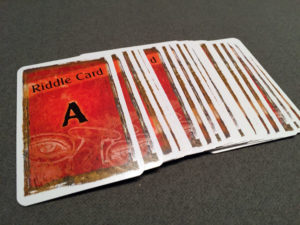
I agree with Brian’s point about number of players. Even with 2 players we often found ourselves passing cards back and forth and the other one just looked around in silence, trying to figure out if we were missing something.
The puzzles vary from super clever to infuriatingly tedious. I was a little disappointed with a couple of them because it wasn’t a matter of figuring anything out, but rather doing a task that was monotonous to get the answers. I don’t want my puzzles to feel like work. For me, this is the biggest shortcoming of escape room board games versus actual escape rooms. You lose the physical and tactical experience so which puzzles can be fun is quite a bit different.
However, the puzzles that did work were really fun. And they definitely outnumbered the bad ones. I imagine I’ll mind myself liking my next EXIT experience better now that I have a feel for the system.
Final Thoughts:
EXIT: The Game was definitely a unique take on the escape room genre, yet it’s not without its flaws. The puzzles ranged from insidiously clever, to outright tedious. And it’s the puzzles that are going to make or break the games.
None of us minded the one-and-done nature of the game play, as it clocks in at about $15. As long as it’s providing an entertaining experience, we were all happy to slice up our cards as we went. While I think Kosmos did an admirable job of trying to distill a physical escape room down to our tabletop, we do think it could benefit from ditching the wheel and using an integrated app in some form.
If you’d like to pick up a copy of EXIT: The Game, you can get it for about $15.
Final Scores:
Tony (The Abandoned Cabin): 3 stars
Brian (The Secret Lab): 2.5 Stars
Andrew (The Pharaoh’s Tomb): 3 Stars
 Hits:
Hits:
• Some very clever and creative puzzles
• Low price point
• Unique game play
Misses:
• Hard to play with more than 2
• Some puzzles bordered on tedious
• Card and wheel system feels dated























Exit: The Game is one of the best games I’ve played this year. I got to know about this game from one of my friends, and I am glad that I took his advice to play the game. I learned a lot of stuff from this game.
One of the best games in this genre. I participated in this quest with my friends and we really liked the sea of impressions. So, when we are in these parts again – we will definitely go again to refresh emotions)))
It seems like a great option for corporate parties) – my colleagues and I often play break games at corporate parties and corporate parties, and this copy will be a great addition to our collection – thank you very much!